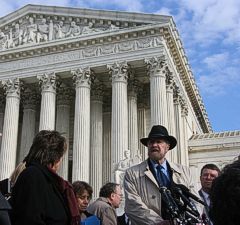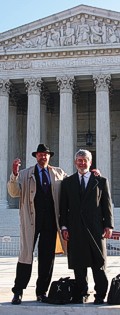
Joe Scheidler speaks to reporters after the hearing Nov. 30 [Photo by EJS]
The clear blue sky over Washington D.C. was the perfect backdrop as Joe Scheidler walked up the steps of the United States Supreme Court for his third appearance before the Justices in Scheidler v. NOW. The Supreme Court building was barricaded due to recent falling stone from the façade. Demonstrators—both pro-life and pro-abortion—lined the sidewalk in front of the granite steps. Reporters and cameramen searched for the principal players in both the Scheidler case and in the New Hampshire parental notification case, Ayotte v. Planned Parenthood, scheduled to be heard right after Scheidler.
While being escorted into the courtroom, we passed Fay Clayton, who was waiting in the lawyers’ line. She cheerfully offered a “Good morning.” Clayton was not arguing on behalf of the National Organization for Women this time around. Instead NOW had hired Duke University constitutional law professor Erwin Chemerinsky, who had written an article slamming the Supreme Court’s 8-1 ruling in favor of Scheidler in 2003.
Three Key Issues Before the Court
The issues at hand in this third appearance were three: Did the Seventh Circuit Court of Appeals defy the Supreme Court’s direction to reverse the 1998 judgment against Scheidler and vacate the injunction imposed by the District Court? Can the Hobbs Act, which defines RICO crimes, be read as broadly as NOW proposes? And can a private party such as NOW get a nationwide injunction from a federal court?
The Thomas More Society, whose chief counsel, Thomas Brejcha, has represented Scheidler and the Pro-Life Action League for nineteen years, called on Alan Untereiner, an appellate attorney with a Washington, D.C. firm, to argue on behalf of the Petitioners (the Scheidler defendants). A few minutes into Untereiner’s presentation, Justice Stevens asked if it was conceivable that the Supreme Court didn’t realize there were four “acts or threats of violence” at issue when they issued their 2003 Opinion.
Tom Brejcha admits his stomach was churning as Stevens suggested the Court might have erred. But then Justice Sandra Day O’Connor commented that it is disturbing to think that “the court below” (the Seventh Circuit) was deliberately trying to defy the Supreme Court. It was difficult to tell whether her comment was sarcastic or if she was seriously concerned.
Did the Seventh Circuit Defy the Supreme Court?
The Justices asked several questions about the wording and interpretation of the Hobbs Act and the Seventh Circuit’s ruling that NOW’s theory might be plausible. The Seventh Circuit had remanded the case to the District Court in 2004, but Scheidler was not willing to risk another day in Judge David Coar’s court, so his attorneys opted instead to appeal directly to the Supreme Court for a final ruling. Questions from Justice Scalia indicated that he found the Seventh Circuit’s position odd and inconclusive.

Joe with fellow petitioner Tim Murphy before the Nov. 30 hearing [Photo by EJS]
Untereiner was very confident and responded effectively to queries presented by Stevens, Ginsburg and Kennedy. He yielded ten minutes of his half-hour to Lisa Blatt representing the United States Solicitor General. She argued in favor of the Scheidler Petitioners on all three issues. Justice Stevens raised the concern that if the Hobbs Act is interpreted as NOW proposes RICO would apply to all sorts of actions that merely obstruct interstate commerce. He asked if there are other criminal statutes to protect the public from harm. Ms. Blatt assured him that there is a laundry list of Federal statutes to cover various types of violence.
Justice Breyer finally got into the act, asking if there isn’t now a specific statute dealing with abortion clinics—the FACE Act—that abortion clinics could rely on if they were targeted with Operation Rescue style activities. Blatt concurred and mentioned that NOW had tried to add FACE charges after the trial, but was denied.
NOW Claims High Court Erred
When Chemerinsky came to the podium, he launched right into NOW’s theory that the Supreme Court had failed to rule on “four counts of physical violence and threats of violence in violation of the Hobbs Act.” Justice Souter jumped in and said, “We made it clear. We said, expressly, that the judgment had to be reversed, which seems to sweep everything within it, doesn’t it?”
Chemerinsky insisted that Souter was wrong. But Souter went on to say that there is a good argument that the Seventh Circuit Court did not honor the judgment of the Supreme Court. And Justice Scalia pounced on Chemerinsky, reminding him that NOW should have filed a motion for re-hearing with the Supreme Court if they believed the Court’s judgment was erroneous.
Chief Justice Roberts reminded Chemerinsky that the last paragraph of the 2003 Supreme Court Opinion said that “all of the predicate acts supporting the jury’s verdict” must be reversed, to which Chemerinsky replied, “And the question, of course, is, what does ‘all’ refer to here?” Roberts quipped, “It’s quite clear what ‘all’ was referring to.”
Ginsburg Asks: What Are the “Four Acts”?
Justice Ginsburg finally asked the crucial question—the question we have been asking for seven years. What are the “four acts?” She said she had looked through all the papers submitted to the Court and could find no specific definition of those acts. “Which four, we have no idea,” she said. Chemerinsky claimed that the trial judge does not need to know which four acts they are. But Ginsburg was not convinced. She pointed out that a judge would have to know what the jury was referring to in order to determine whether a particular combination of four acts would be sufficient to sustain a nationwide injunction.
Turning to the meaning of the Hobbs Act, there was a lengthy discussion of the importance of a “comma” in the text, the meaning of the word “or” and the word “by.” Chemerinsky quoted the portion of the Hobbs Act that he said would support NOW’s interpretation of the Act, but Scalia pointed out that he had omitted a key phrase that clearly limits the crimes under the Hobbs Act to extortion and robbery “in furtherance of a plan” to do anything in violation of the Act.
Breyer Troubled by NOW’s Theory
Justice Breyer expressed concern that NOW’s interpretation of the Hobbs Act would make a federal crime out of virtually every threat of violence made anywhere in the United States. He went on to say that almost everything affects commerce and that NOW’s theory turns fairly minor matters of state criminal law into Federal crimes.
Chemerinsky mentioned several times that the Supreme Court had “reversed and remanded” the case to the lower court. Scalia finally challenged him, pointing out that the Court simply said, “Reversed.” Did the Seventh Circuit say that “what we meant was not ‘reversed,’ but ‘reversed and remanded?'” Scalia kept repeating that the last line of their ruling says “reversed.”
9-0 Pro-Life Victory Seems Possible
Justice Stevens summed up the Supreme Court’s original ruling: “We actually entered a mandate.” This last comment left us with the impression that even Justice Stevens may be prepared to rule in our favor in this third go-round. That would give us a 9-0 victory.
A ruling will likely be issued in late January or early February.
Related Articles and Pages
- Scheidler To Make Historic Trip to the Supreme Court—Spring/Summer 2005 Action News article
- Despite High Court Victory, NOW v. Scheidler Lives On—Winter 2005 Action News article
- Fay Clayton’s Endgames—June 2003 Action News article
- NOW v. Scheidler Case Summary—From 1986 to the present
